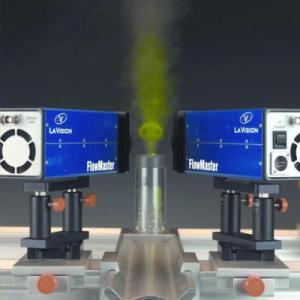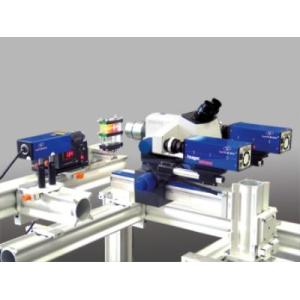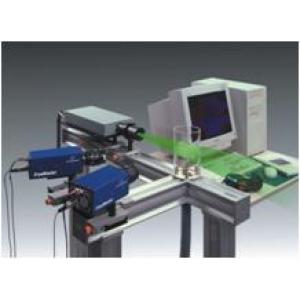测量效果: 平面(二位/三维)
产地类别: 进口
测量频率: 低频
测速范围: 0-2km/s
测定准确度: 1%
测量区域大小: 0-1mx1m
看了粒子图像测速仪(PIV)的用户又看了
LaVision 公司致力于研发前沿尖端的PIV测量系统迄今已逾20年,型号功能丰富的标准和用户定制FlowMaser® PIV系统在全世界的用户现场安装运行。优异的性能值得信赖。科学家和工程师们用他们出色的测量结果对LaVision的研发和创新能力给予了充分的肯定。LaVision公司提供的的解决方案,不仅是简单的一件易用工具,更是一套适应范围广,功能全面而灵活的智能化测试系统。我们的PIV分析软件算法,在连续三年的评测活动PIV Challenge中得到了优秀的结果。我们独创的专利的自标定算法为测试片光和标定板的偏离提供了精读更高,更为安全高效的,无需手动干预的自动补偿能力。
FlowMaster@-UW 水下PIV系统采用模块化结构。能够配置成多种几何形态的测量系统。同时维持高的光学成像精确度。我们设计的紧凑型潜望管道镜和鱼雷体水下PIV测量系统,对被测水流的干扰可以降低到最小。同时电子设备可以安全地放置到水面以上(欢迎咨询细节)。浸没水下的设计则采用了体积小巧的遥控高分辨率PIV相机。经过精心设计和加工确保了整个系统的机械刚性,强度并经过严格的实地运行检测验证。水下部件设计的原则是尽量减小体积尺寸,降低对被测流动的干扰。
系统采用高质量的光学元件和巧妙可靠的控制机制。所有这些综合在一起,为水下流体运动规律的测量应用提供了一套精密的测量系统。LaVision公司在其他例如空气动力学,汽车和透平机械领域的用户对这些有良的性能已经早有深刻的体会。
保修期: 1年
是否可延长保修期: 是
现场技术咨询: 有
免费培训: 一人次
免费仪器保养: 质保期内一次
保内维修承诺: 全天候电话邮件微信远程连接支援服务
报修承诺: 一周内到达用户现场开始维修

德国LaVision PIV/PLIF粒子成像测速场仪
型号:FlowMaster® 150万 - 200万
显微粒子成像测速系统(Micro PIV)
型号:FlowMaster®-Micro 80万 - 100万
电动层析显微粒子成像测速PIV-Mitas
型号:FlowMaster®-Mitas 80万 - 100万
三维立体PIV
型号:FlowMaster® 3D 100万 - 120万本文给出了第三届国际PIV评测活动(PIV Challenge)的主要结果。这次评测是和PIV05国际研讨会在相同地点,相同时间举行的相关活动。本文介绍了评测活动的宗旨,描述了测试的项目和参与单位采用的相关算法,给出了主要的评测结果和相关分析,同时给出了对于各种不同的PIV和PTV算法的精度和鲁棒特性的总结。由于所得到的全部结果内容较多,无法在此文种尽述。因此本文只能起到使用全部的数据库文件,图像和结果的向导的作用。详细数据可访问http://www.pivChallenge.org.获得。 --------------------------------------------------------------------- 想要获得本文全文的朋友请联系: 北京欧兰科技发展有限公司 ----------------------------------------------------------------------------------------------------- 北京市海淀区上地十街1号辉煌国际中心1号楼1006室。邮编100085 电话: +86-10-62623871,62616041,62612809-18 传真: +86-10-59713638 手机:13001184981,13611196791 电邮: oplan@263.net oplanchina@gmail.com 网址: www.oplanchina.com www.dpiv.cn ------------------------------------------------------------------------------------------------------
DaVis是德国LaVsion公司推出的应用于反应和非反应流场测量,材料表面成像和追迹以及超快成像的智能(激光)成像技术的完整软件平台。 DaVis以灵活的图像采集模块,可用户定制的应用界面和特殊应用软件包三大特色功能成就了完美的成像系统所需软件。 DaVis软件可满足用户以纳秒量级的精度进行相机曝光,外部照明以及外部触发的同步控制并能自由选择采集图像序列。除此之外,DaVis软件拥有各种成像设置和控制的功能。 DaVis软件对用户开放,这种特色结合软件本身的宏命令语言,能够使得成像系统快速适应从高深的科学研究到可靠的工业应用等各种不同测量需求。 不仅如此,DaVis还拥有灵活的图像采集模式,先进的图像处理算法,多维图像数据的智能存储和显示,多种硬件的软件控制等功能。 集成了2DPIV和3DPIV功能模块的DaVis软件,参加了连续三年的PIVChallenge(http://www.pivchallenge.org)评测活动,均取得了优异成绩。客观证明了DaVis软件平台的出色性能。 PIVChallenge的组织者将两次PIVChallenge 活动的结果作了详尽的总结,并将结果发表在了公开的网站和杂志上。有关文章和下载网址如下: 1. Stanislas M, Okamoto K, Kaehler C (2003) Main results of the First International PIV Challenge. Meas Sci Technol 14:R63-R89 下载地址: http://stacks.iop.org/0957-0233/14/R63 或: http://www.oplanchina.com/download/Stanislas PIV challenge 2001.pdf 2. Stanislas M, Okamoto K, Kaehler C, Westerweel J (2005) Main results of the Second International PIV Challenge. Exp Fluids 39: 170-191 下载地址:http://www.oplanchina.com/download/PIV Challenge 2003 Results.pdf
The latest issue of the journal Measurement Science and Technology is focusing on uncertainty quantification in Particle Image Velocimetry The need to put an uncertainty band on a PIV vector has long been missing in the PIV community. In recent years, several methods that address this need have emerged in the literature. For this reason, Measurement Science and Technology is addressing uncertainty quantification in PIV with its recent issue. In addition to an editorial written by Prof. Kenneth T. Christensen and Prof. Fulvio Scarano, this issue contains four papers dealing with uncertainty quantification in Particle Image Velocimetry. Three of these papers are from LaVision and its research collaboration partners. These papers are (1) the introduction of the correlation statistics (CS) method, (2) the creation of an experimental database for evaluating existing PIV uncertainty methods, (3) a detailed comparison of existing PIV uncertainty methods (using this database). Please find more information about the latest issue here. Share this article:
LaVision GmbH粒子图像测速FlowMaster®-UW的工作原理介绍
粒子图像测速FlowMaster®-UW的使用方法?
LaVision GmbHFlowMaster®-UW多少钱一台?
粒子图像测速FlowMaster®-UW可以检测什么?
粒子图像测速FlowMaster®-UW使用的注意事项?
LaVision GmbHFlowMaster®-UW的说明书有吗?
LaVision GmbH粒子图像测速FlowMaster®-UW的操作规程有吗?
LaVision GmbH粒子图像测速FlowMaster®-UW报价含票含运吗?
LaVision GmbHFlowMaster®-UW有现货吗?
最多添加5台
